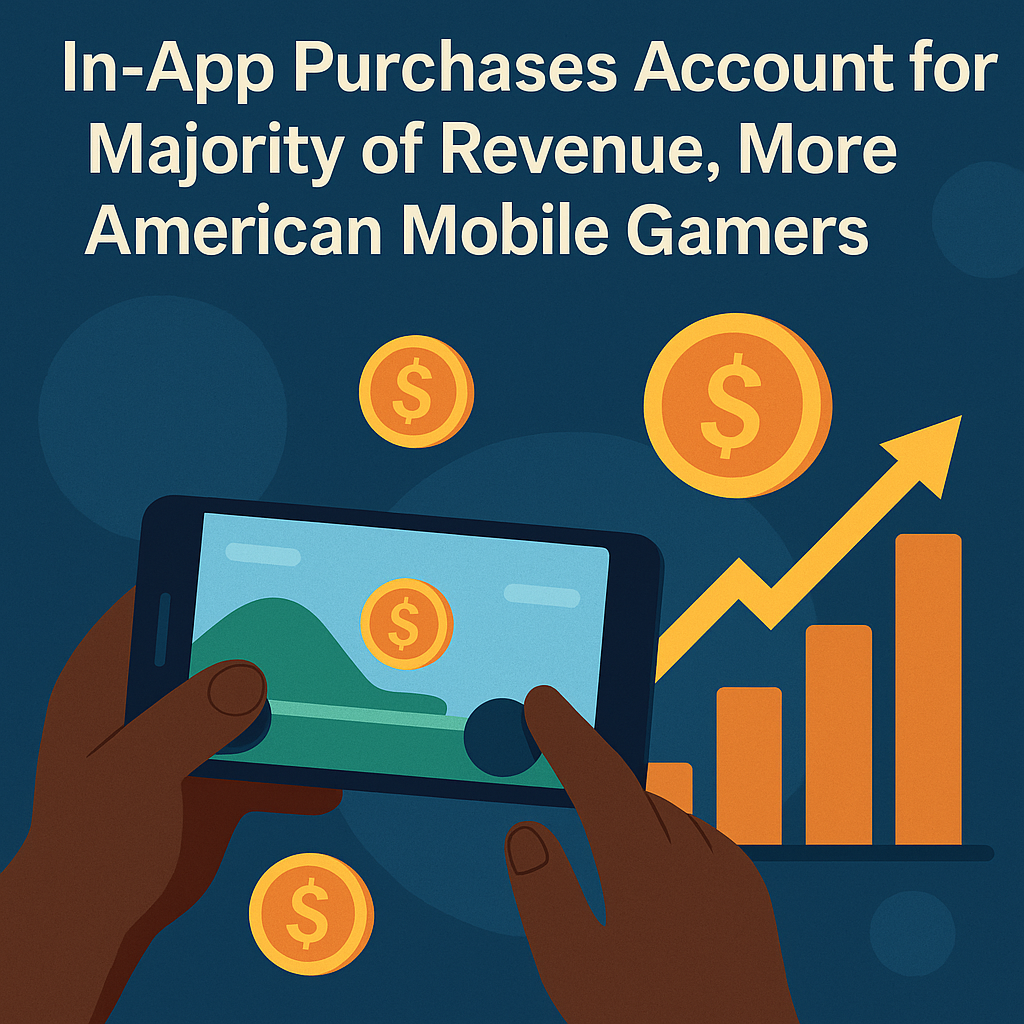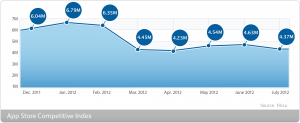In-App Purchases Account for Majority of Revenue, More American Mobile Gamers
I’ve been a mobile gamer for years, and games like Candy Crush or Clash of Clans clearly illustrate why in-app purchases account for the majority of revenue, hooking us with free downloads before tempting us to spend on extras.
It’s no secret that these purchases are a goldmine for developers, especially in the U.S., where mobile gaming is booming. In 2025, with more Americans playing mobile games than ever, IAPs are driving the lion’s share of revenue, fueled by a growing player base and clever monetization strategies. But why are IAPs so dominant, and what’s behind the surge in American mobile gamers? Let’s break it down.
The Power of In-App Purchases
When I first got into mobile gaming, I figured free games made money through ads or maybe a few paid downloads. But the data tells a different story. In 2024, Sensor Tower reported that in-app purchases accounted for 95% of user spending in mobile games, dwarfing other revenue streams like paid apps or subscriptions. In the U.S., mobile games generated $23.44 billion from IAPs in 2024, with virtual goods like in-game currency and bundles making up $22.50 billion of that, according to eMarketer’s forecast.
Why are IAPs so huge? For one, free-to-play (F2P) games dominate the market—98% of Google Play apps are free. You download a game like Fortnite for free, get hooked, and suddenly you’re eyeing a $10 skin to stand out in a match. Developers make it easy—purchases are a tap away, linked to your App Store or Google Play account. Plus, games are designed to nudge you toward spending, whether it’s a limited-time offer or a power-up to beat a tough level.
The revenue isn’t spread evenly, though. A tiny group of players, often called “whales,” drives most of it. A 2016 Swrve study found that just 0.19% of mobile gamers accounted for 48% of IAP revenue, and this trend holds in 2025. These high spenders drop hundreds or thousands on games, while most of us stick to small purchases or none at all. For example, Unity’s 2024 report says only 1.83% of U.S. mobile gamers make IAPs, but those who do often spend repeatedly, with 26.47% making a second purchase within 30 days.
Why More Americans Are Playing Mobile Games
The number of American mobile gamers is skyrocketing, and it’s no surprise why. By 2027, the U.S. is expected to have 182 million mobile gamers, up from 161 million in 2023, per Xsolla’s 2024 report. That’s over half the population, and I’ve seen this shift in my own circles—friends, family, even my parents are tapping away at puzzle games or RPGs. Here’s what’s driving the boom:
- Accessibility: Smartphones are everywhere—66% of the global population owns one, per Zippia’s mobile gaming stats. You don’t need a $500 console; a $200 phone and a free app get you in the game.
- Diverse Demographics: Mobile gaming isn’t just for kids. Women make up 55% of U.S. mobile gamers, and they’re 79% more likely to spend on IAPs than men, according to MarketingDive’s 2023 study. Older players are also jumping in—65+ gamers play 25 hours a month, per Ipsos’ 2023 GameTrack.
- Casual Appeal: Games like Royal Match or Block Blast are easy to pick up and play during a commute or while waiting at the dentist. Statista’s 2024 survey found that casual games, which rely heavily on IAPs, are the mostí most downloaded in the U.S., making up 78% of total downloads.
- Pandemic Boost: Lockdowns in 2020 pushed more people to mobile games for entertainment and social connection, with 45% of U.S. gamers playing more due to extra time, per FinancesOnline’s 2021 stats.
This growing player base means more potential spenders, even if only a small percentage buy IAPs. Developers use AI-driven analytics to boost conversions, just like marketers fine-tune app engagement through design tools to attract repeat users.
How Developers Make IAPs Irresistible
I’ve fallen for it myself—you’re stuck on a level, and a pop-up offers a $2.99 bundle to keep going. Developers use smart tactics to drive IAPs, and they’re working better than ever:
- Game Design: Games are built to create “pain points” (like running out of lives) that IAPs solve. Candy Crush famously limits you to five lives, nudging you to buy more or wait 30 minutes, as noted in Udonis’ IAP guide.
- Personalization: Using player data, developers tailor offers, similar to how targeted mobile marketing boosts app revenue and retention.
If you’re a frequent player, you might see a deal on a currency pack. SDLC Corp’s 2024 analysis says this can increase conversion rates by 20%. - Exclusive Content: Americans love unlocking unique items—think skins in Fortnite or new characters in Genshin Impact. A 2024 Newzoo survey found that 52% of U.S. gamers cite exclusive content as their top reason for IAPs.
- Social Pressure: Multiplayer games like Clash of Clans use clans to encourage spending on upgrades to stay competitive, boosting engagement by 4%, per UCLA Anderson’s 2022 study.
These emotional hooks drive engagement, just like overpricing an app can turn potential buyers away.
overpricing an app can turn potential buyers away.
Challenges of Relying on IAPs
Relying on IAPs isn’t without risks, and I’ve seen games flop when they get it wrong. Here’s what developers need to watch out for:
- Player Pushback: If IAPs feel mandatory, players quit. A 2021 App Annie report found 60% of players abandon games with aggressive paywalls, like Ski Champion’s pay-to-win setup.
- High Acquisition Costs: Getting a paying user costs $86.61 on average, per Wappier’s 2020 IAP stats, so developers need a big audience to break even.
- Market Saturation: With 700,000+ games in the app stores, visibility is everything, which is why developers still rely ontiming launches and updates strategically.
Sensor Tower’s 2025 data shows a 6% drop in downloads since 2021, meaning marketing is critical. - Retention Struggles: Only 25% of players stick around after 30 days in top F2P games, per App Annie. Keeping us engaged with new content is expensive.
Despite these challenges, the U.S. market’s growth—12.3% year-over-year spending in 2024, per Xsolla—makes IAPs a safe bet for now.
Real-World Examples of IAP Success
Some U.S.-loved games show how IAPs drive revenue:
- Candy Crush Saga: Generates $1.2 billion yearly, per Enterprise Apps Today’s 2022 stats, with IAPs for lives and boosters.
- Fortnite: Made $5 billion in 2021, mostly from skins, per Forbes’ Epic Games profile.
- Genshin Impact: Earned $2 billion in its first year, with gacha-style IAPs for characters, per Business of Apps’ game stats.
- Coin Master: Grossed $912 million in 2021 on Google Play, driven by spins and upgrades, per Sensor Tower’s 2021 report.
These games thrive by offering fun free experiences and tempting us with optional purchases that feel worth it.
Why the U.S. Is a Hotspot for IAPs
The U.S. stands out because of its large, diverse player base and spending power. Women, older players, and casual gamers are driving growth, with 50% of adult U.S. gamers spending $1–$50 yearly on games, per CivicScience’s 2024 survey. The U.S. is the top market for seven of the world’s 10 highest-grossing games, per Xsolla, and cultural trends—like valuing personalization and status—make IAPs for exclusive content a hit. Plus, fast internet and widespread smartphone use mean we’re always a tap away from spending.
What’s Next for IAPs and U.S. Gamers
Looking ahead, I see IAPs staying dominant as developers get smarter with AI and personalization. Hybrid monetization—mixing IAPs with ads or subscriptions—is up 20% in 2024, per AppsFlyer’s gaming report. Web shops, where 77% of players buy directly from developers, are also growing, per Xsolla, cutting out app store fees. With the U.S. mobile gaming market projected to hit $29.1 billion by 2027, per FinancesOnline, and genres like casual and RPG leading IAPs, the future looks bright.
If you’re a gamer or developer, think about what makes you spend. For me, it’s usually a cool skin or a time-limited event. To tap into U.S. mobile gaming growth, focus on fairness and joy—just like successful devs who launch smart, even on tight budgets with the right dev teams.


